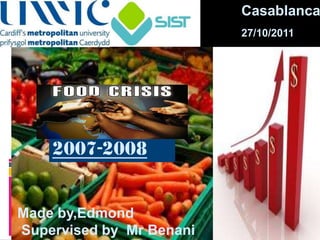Food raise of price e
- 1. Casablanca 27/10/2011 2007-2008 Made by,Edmond Supervised by Mr Benani
- 2. Content ÔÉò Historic ÔÉò Causes ÔÉò Consequences -Macro Economic -Micro Economic ÔÉò Alternatives ÔÉò References
- 3. Historic Price trends Global increase of Food: ÔÇß Increase of 12% from 2005 to 2006, 24% in 2007 and Raise 50% in January a great peak ÔÇß Decrease then increased 2009- 2010 ÔÇß Peaking again slightly to the one of 2008
- 4. ÔÇß Between 2006 and 2008 average world prices for rice rose by 217%, ÔÇß wheat by 136%, ÔÇß corn by 125% and ÔÇß soybeans by 107%. ÔÇß soya by 87%, and maize 31%
- 5. Causes  Scarcity of Resources(land,raw materials…drought in grain producting countries  Raise of Oil price - Hight cost of fertilizers - Hight cost of Food Transportation - Industrial agriculture
- 6. ÔÇß Growth of world population ÔÇß Hight demand ÔÇß Financial speculation ÔÇß Lack of Rain ÔÇß Vulnerability of the current agricultural and food model
- 7. Consequences  MacroEconomic o Increase of 12% from 2005 to 2006, 24% in 2007, and a rise of about 50% in January and July 2008. FAO Price Index at current prices (black curve) and corrected for inflation (blue curve) between January 2004 and May 2011
- 8. oRise of the oil ‘s price combined with global raise of food price and other leads to the global inflation oGreat fear of Financial market s:stocks markets Example of Wall street, oAffect the global Economy
- 9.  Micro economic o Switch to other foods or other business o Wholesalers incresase more the price of food o Retailers raise it again o Purcahsing power become insignificant to afford the purchase of food o Decrease of consumer confidence o Increase of anger
- 10. oUnrest around the world 1. Mauritania, 8 Morocco 2. Cameroon 10 Mexico 3. Senegal 11 Bolivia 4. Burkina Faso 13 Yemen 5. Côte d'Ivoire 14 Uzbekistan 6. Egypt 15 Pakistan 7. Bangladesh 16 Sri Lanka 8. South Africa. …………..
- 12. Alternatives ÔÇß ÔÇßInterventions of Governements(bailout,being owner of certains banks..) ÔÇßMore Grants to the farmers ÔÇßSupport Small scale and sustainable production. ÔÇßIT IS NECESSARY TO GENERATE MECHANISM OF INTERVENTION AND REGULATION
- 13. ÔÇß Government intervention: ÔÇß -IFAD $200million to support poor farmers ÔÇß -April 30, 2008 creation of the organition of rice exporting countries ÔÇß - June 2008 the food and agriculture organization hosted conference in which $1.2 billion in food aid
- 14. References  Ester,V.,2008.Causes Consequences and Alternatives:International Viewpoint[Online].Available at:< http://www.internationalviewpoint.org/spip.php?article1774>[Accesse d 24 October 2011]  Rolf,K.,Reinhard and Jutta,W.,2010. What Became of the Food Price Crisis in 2008?.[Online] Züric: “Aussenwirtschaft”.  Swiss Review of International Economic Relations.Available at :< http://www.nadel.ethz.ch/publikationen/food_price_crisis.pdf>[Access ed 24 October 2011]  Food and Agricultural Organization Of the United Nations.2011 How does international price volatility affect domestic economies and food security?FAO  Joachim,V.B.,2008. Food and financial crises: Implications for agriculture and the poor.IFPRI Policy Brief 7.Washington,DC:International Food Policy Research Institute














![References
ÔÇß Ester,V.,2008.Causes Consequences and Alternatives:International
Viewpoint[Online].Available at:<
http://www.internationalviewpoint.org/spip.php?article1774>[Accesse
d 24 October 2011]
ÔÇß Rolf,K.,Reinhard and Jutta,W.,2010. What Became of the Food Price
Crisis in 2008?.[Online] Züric: “Aussenwirtschaft”.
ÔÇß Swiss Review of International Economic Relations.Available at :<
http://www.nadel.ethz.ch/publikationen/food_price_crisis.pdf>[Access
ed 24 October 2011]
ÔÇß Food and Agricultural Organization Of the United Nations.2011 How
does international price volatility affect domestic economies and
food security?FAO
ÔÇß Joachim,V.B.,2008. Food and financial crises: Implications for agriculture
and the poor.IFPRI Policy Brief 7.Washington,DC:International Food Policy
Research Institute](https://image.slidesharecdn.com/foodraiseofpricee-120428135609-phpapp01/85/Food-raise-of-price-e-14-320.jpg)